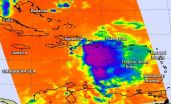(Press-News.org) Researchers link babies' performance on cognitive tasks to later learning progress
Study underscores importance of talking to your baby well before they can talk back
Findings may eventually contribute to reducing "vocabulary gap"
EVANSTON, Ill. --- At 12 months old, your infant's ability to group objects according to the names associated with them -- as opposed to their appearance alone -- offers a glimpse into how his or her vocabulary will develop by the time they are 18 months, Northwestern University researchers have found.
The research, by Brock Ferguson, Melanie Havy and leading developmental scientist Sandra Waxman, in the psychology department in the Weinberg College of Arts and Sciences, will appear in an upcoming issue of the open access journal Frontiers in Psychology.
"Our findings offer one piece of the very large puzzle that is vocabulary development," said Ferguson, lead author of the study and a doctoral candidate in cognitive psychology.
"This is a big first step toward using these cognitive tasks to identify infants at risk for language delays."
The study examined whether individual differences in the precision of 12-month-olds' ability to link language and object categories was related to both their present and future vocabulary growth.
Ferguson offers a real-world analogy to the situation researchers create in the lab to measure infants' use of names as a guide to object categorization.
"Imagine you are taking your baby for a visit to the primate house at the zoo," he said. "There are gorillas, chimpanzees and monkeys in the primate house. Although all the primates look fairly similar, but we know them to be different because we refer to them by different names."
In that hypothetical scenario, 12-month-old babies who conclude that all of the primates belong in the same category, despite the fact that mom has referred to each by a different name, tend to have a less developed vocabulary, according to Ferguson's findings.
"In out study, babies who went ahead and grouped objects together even though the researchers had labeled them with distinct names were later found to know fewer words," Ferguson said.
Cognitive development is broadly defined as the process by which babies and young children learn about the world around them, and includes the acquisition of problem solving, memory, perception and, of course, language.
Working at the Project for Child Development, Waxman and her colleagues have already shown that talking to young children, even before they can speak, strengthens their language and cognitive abilities.
"This new finding is the first to link infants' performance on our cognitive task to their progress in learning new words," said Sandra Waxman, the Louis W. Menk Chair in Psychology, a professor of cognitive psychology and a faculty fellow in the University's Institute for Policy Research.
INFORMATION:
(Source contact: Brock Ferguson, BrockFerguson2011@u.northwestern.edu)
NORTHWESTERN NEWS: http://www.northwestern.edu/newscenter/
This news release is available in Spanish. Marine energy has a great future potential according to the experts, but there is still a long way to go before it can be used on a large scale. Despite the problem of intermittency, wave energy has an advantage over wind energy, for example: it is easier to predict optimum swell than some suitable gusts of wind. That is why knowing how much energy the waves will be bringing within a few hours is as important as having available efficient prototypes to make use of wave power. If this information is known, the energy produced ...
PITTSBURGH, Aug. 31, 2015 -- People with hostile personality traits who watch more television than their peers may be at a greater risk for injury, potentially because they are more susceptible to the influence of television on violence and risk-taking behaviors, a University of Pittsburgh Graduate School of Public Health analysis discovered.
The research, published online in the International Journal of Injury Control and Safety Promotion, suggests that a reduction in television viewing and content rating systems geared not just to age, but also personality traits, ...
Life on an island isn't always easy. To make the most of the little there is to eat on many Greek islands, the digestive system of Balkan green lizards has evolved considerably compared to family members on the mainland. Surprisingly, many of these insect-eating lizards even have special valves that help to digest plants. These are some of the findings¹ from a study led by Konstantinos Sagonas of the National and Kapodistrian University of Athens in Greece, published in Springer's journal The Science of Nature².
Reptiles can adjust their digestive system and ...
PITTSBURGH, Aug. 31, 2015 -- The more hours young adults spend watching television each day, the greater the likelihood that they'll have a higher body mass index and bigger waist circumference, a 15-year analysis by the University of Pittsburgh Graduate School of Public Health revealed.
The association did not hold in later years, indicating that young adulthood is an important time to intervene and promote less television viewing, according to the research published online in the journal SAGE Open.
"We were quite surprised to find that television viewing was associated ...
ROCHESTER Minn. -- A team of Mayo Clinic Cancer Center scientists has been awarded a Specialized Program of Research Excellence (SPORE) grant in multiple myeloma from the National Cancer Institute. The Mayo Clinic Cancer Center is one of only three cancer centers to receive a SPORE grant for multiple myeloma cancer research.
MULTIMEDIA ALERT: Video and audio are available for download on the Mayo Clinic News Network.
"With project leaders from Mayo campuses in Arizona, Rochester and Florida, our SPORE team will study the genetic basis for myeloma, develop novel viral ...
Satellite data from NOAA's GOES-East satellite was made into an animation that showed the demise of former Tropical Storm Erika as it neared eastern Cuba early on August 29.
At NASA's Goddard Space Flight Center in Greenbelt, Maryland, NASA/NOAA's GOES Project compiled three days' worth of imagery from NOAA's GOES-East satellite that showed the movement and changes in former Tropical Storm Erika from August 27 to August 29. The animation showed Erika move through the Leeward Islands and into the Eastern Caribbean Sea, as its center passed just south of Puerto Rico, then ...
London, UK - 30 Aug 2015: Recruitment of leukocytes is a hallmark of stent thrombosis, according to results from the PRESTIGE study presented today at ESC Congress1 and published in European Heart Journal.2 The findings suggest that immune cell mediated thrombotic processes may be a realistic target for novel therapies to prevent stent thrombosis.
"Stent thrombosis (ST) is a life-threatening complication of percutaneous coronary intervention and recent large scale clinical registries reported an incidence of up to 0.4-0.6% per year," said principal investigator Professor ...
How did the ankylosaur get its tail club? According to research from North Carolina State University and the North Carolina Museum of Natural Sciences that traces the evolution of the ankylosaur's distinctive tail, the handle arrived first on the scene, and the knot at the end of the tail followed.
The typical ankylosaur had a wide armored body and a flexible tail. But one group of ankylosaurs - ankylosaurids - also had a tail club that could have served as a useful weapon. These "weaponized" ankylosaurids lived about 66 million years ago, during the Cretaceous period. ...
LONDON (Aug. 31, 2015) -- Cardiologists failed to identify more than half of basic and about 35 percent of advanced pre-recorded murmurs, but skills improved after a 90 minute training session, according to research presented today at the European Society of Cardiology Congress 2015.
Recent breakthroughs in the transcatheter treatment of aortic and mitral valve disorders provide new therapies for patients, but physicians must be able to detect valve problems in a timely manner for patients to see the full benefit of these advances, said Michael Barrett, MD, the lead ...
London, UK - 31 Aug 2015: A gene associated with sudden cardiac death in the general population has been identified using implantable cardioverter defibrillator (ICD) monitoring in research presented for the first time at ESC Congress today.1 The research included patients from the DISCOVERY trial and Oregon-SUDS and discovered that a polymorphism in the GNAS gene predicted ventricular tachyarrhythmias and sudden cardiac death.
"This is the first time a gene has been identified using ICD monitoring and then confirmed to be associated with sudden cardiac death in the general ...


